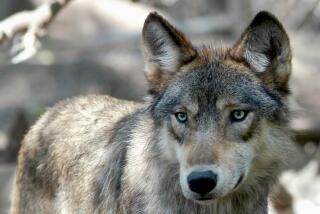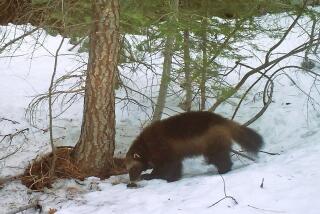AT HOME : A Wolf in Dog’s Clothing? : Hybrids of the two animals can be man’s best friend--or his worst enemy. A wildlife activist says breeding them is unfair to the animals.
- Share via
Gaze into the slate-blue eyes of a Siberian husky, and you just might find an Arctic wolf staring back at you.
Crossbreeding huskies, mala mutes or German shepherds with wolves has grown in popularity in recent years, evidenced by a near doubling of the number of hybrids at the Wildlife Waystation in the Angeles National Forest.
Some believe the result is a genetic crapshoot that is unpredictable and often dangerous. Others maintain that the animals can make superb, nearly mystic pets and retain a wolf’s heightened communication faculties without its shyness and fearfulness of humans.
“We get calls from people who’ve kept hybrids as pets who say, ‘We thought it was a great idea,’ but the animal destroyed their home, attacked their neighbor’s animals or leaped their 6-foot fence,” says Martine Colette, president and founder of the Waystation, a refuge that shelters about 1,000 orphaned and abused wild and exotic animals. “It can be a complex animal that’s hard to train and easy to misread.” She says she has even received calls about humans being maimed and killed by hybrids.
The center’s 40 hybrids are housed in large pens near a population of about a dozen wolves, so the two groups can socialize, mainly through howling and exchanging looks. The hybrids, mostly failed pets that arrive from all parts of California, are easily mistaken for dogs. Wolf traits, such as long legs, a large head, distinctive gait and coats that range from black to white, may or may not appear.
“This is the only animal we really can’t place anywhere,” Colette says. “Zoos won’t accept them. They aren’t capable of surviving in the wild, and can’t be placed as pets because of liability problems. It’s sad, but the only thing we can do is offer the animal some quality of life.”
The number of hybrids nationwide has been estimated as high as 500,000. Their bad reputation has come partly from highly publicized incidents. In April, 1990, a hybrid ripped the right arm off 16-month-old Tyler Olson in New Jersey. Also that year, in Alaska, a hybrid grabbed 4-week-old David Paul Mahler by the head, puncturing his soft skull and killing him.
The owner of the hybrid said it did not bite the infant, explaining that mother wolves transport their pups by the head.
“People who raise hybrids always feel they’re different, that they can do a good job raising them, while others can’t,” Colette says. “But in the end, it’s the animals that lose out.”
Dick Weigand of West Hills disagrees. Three years ago, he found Duchess, a 50% blend of Arctic, Asian gray and timber wolf, mixed with husky. He mated Duchess with Chino, a similar mix, who sired six pups, one of which Weigand has kept.
“I’ve never had more intelligent animals,” Weigand says. “I just don’t understand why people are upset about these animals. When I got these dogs I got rid of my Doberman, because I thought he had more potential for violence. These dogs are affectionate, gentle and loyal.”
Gazing into Chino’s amber, wolfish eyes, Weigand said it’s the wolf’s ability to communicate--a trait that often appears in hybrids--that enamored him. “It’s uncanny,” he says. “I can feel their intention. The dogs definitely treat everyone individually, in a way I think other animals aren’t capable of doing.”
Barry Holstun Lopez, author of the book “Of Wolves and Men,” believes wolves exchange signals through their intense stares, often leveled at prey in a kind of “conversation of death” that honors the prey’s imminent demise.
But some moose have walked away from stare-downs with wolves; Lopez conjectures that this stems from the wolf’s regard for an individual moose’s strength, even though wolves have no trouble killing such a large animal.
A West Valley breeder of hybrids says the wolf stare is also what first attracted her to the animal.
“It’s a very deep look, like they know what you’re thinking,” says Marian, who asked that her last name not be used. “It’s eerie.”
Marian says responsible breeders mate hybrids for stable temperaments, rather than for a wolfish look.
“If you breed things that are scared and skittish, you’re going to have problems. And if you end up with an animal that’s above 80 to 85% wolf, you’re going to have too little dog. You don’t have a pet anymore. You have an exotic.”
Colette concedes that not all wolf hybrids should be labeled as the Saddam Hussein of the animal world.
But as long as inconsistencies in them occur, she says, they should not be bred.
“The key question is, what does the hybrid get out of this?” Colette says. “There’s always the exception, but a high percentage of hybrids are bad. You can have a litter of six pups, and you can get all dispositions--there’s no continuity.
“And do people really have the right to breed these animals just to get a small percentage that are good? They’re thinking of themselves, instead of the welfare of a species.”
More to Read
Sign up for Essential California
The most important California stories and recommendations in your inbox every morning.
You may occasionally receive promotional content from the Los Angeles Times.










